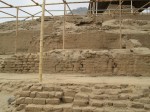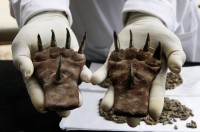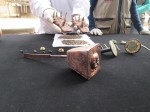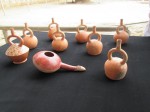 The ancient capital of the Moche culture lies five miles south of the city of Trujillo on the northern coast of Peru. Its inhabitants lived in an urban center bracketed by the Temple of the Sun and the Temple of the Moon, the largest adobe structures known. The Spanish looted the former extensively, diverting a river to erode the bricks and wash out the gold from burials of Moche rulers. The Temple of the Moon is in better condition and still retains 200 square feet of painted murals depicting the daily life, human sacrifice, deities, wars of a people who have left no written records. The Pyramids of the Sun and the Moon Archaeological Project has been excavating the site for 20 years, and still it holds magical surprises.
The ancient capital of the Moche culture lies five miles south of the city of Trujillo on the northern coast of Peru. Its inhabitants lived in an urban center bracketed by the Temple of the Sun and the Temple of the Moon, the largest adobe structures known. The Spanish looted the former extensively, diverting a river to erode the bricks and wash out the gold from burials of Moche rulers. The Temple of the Moon is in better condition and still retains 200 square feet of painted murals depicting the daily life, human sacrifice, deities, wars of a people who have left no written records. The Pyramids of the Sun and the Moon Archaeological Project has been excavating the site for 20 years, and still it holds magical surprises.
 The latest surprises are some wonderfully vicious-looking feline claws made of metal in the 1,500-year-old tomb of an elite man excavated under the urban center of the site. The claws were found towards the top of the burial, below his head around neck or shoulder height and archaeologists aren’t sure how they were worn. They could have been part of a costume used in ritual combat where the winner was given the claws as a prize and the loser was sacrificed.
The latest surprises are some wonderfully vicious-looking feline claws made of metal in the 1,500-year-old tomb of an elite man excavated under the urban center of the site. The claws were found towards the top of the burial, below his head around neck or shoulder height and archaeologists aren’t sure how they were worn. They could have been part of a costume used in ritual combat where the winner was given the claws as a prize and the loser was sacrificed.
 Big cats and deities with feline characteristics played an important role in Moche cosmology. They are frequently depicted in figurines, murals and painted on ceramic vessels. One of the painted friezes at the Temple of Moon, as a matter of fact, depicts large felines attacking and killing human victims, and a feline features prominently on what may be the most important artifact discovered in the tomb: a pyramid-shaped copper scepter which is topped with the face of a feline, fangs bared. The four sides of the scepter are also decorated, three of them with warriors displaying their weapons and the fourth with a large cat that has just killed a nude prisoner.
Big cats and deities with feline characteristics played an important role in Moche cosmology. They are frequently depicted in figurines, murals and painted on ceramic vessels. One of the painted friezes at the Temple of Moon, as a matter of fact, depicts large felines attacking and killing human victims, and a feline features prominently on what may be the most important artifact discovered in the tomb: a pyramid-shaped copper scepter which is topped with the face of a feline, fangs bared. The four sides of the scepter are also decorated, three of them with warriors displaying their weapons and the fourth with a large cat that has just killed a nude prisoner.
 The scepter is very similar in shape and design to one discovered in the tomb of the Lord of Sipán with one major difference: Sipán’s sceptre was made of gold, not copper. The scepter is a symbol of rule, but the copper indicates this man was a local ruler, certainly a person of high social rank, but a vassal of Moche royalty rather than standing atop the hierarchy himself. Hence the preponderance of copper and brass in the tomb. The only gold found was a few modest pieces inlaid in a pair of large round earplugs. The quality of the earplugs again is high, but not the highest. He was a nobleman, a political or religious leader, possibly an envoy sent to newly conquered territories.
The scepter is very similar in shape and design to one discovered in the tomb of the Lord of Sipán with one major difference: Sipán’s sceptre was made of gold, not copper. The scepter is a symbol of rule, but the copper indicates this man was a local ruler, certainly a person of high social rank, but a vassal of Moche royalty rather than standing atop the hierarchy himself. Hence the preponderance of copper and brass in the tomb. The only gold found was a few modest pieces inlaid in a pair of large round earplugs. The quality of the earplugs again is high, but not the highest. He was a nobleman, a political or religious leader, possibly an envoy sent to newly conquered territories.
 The high status is confirmed by the presence of a metal mask that once covered his face. It is in pieces now, but the shiny metal buttons used to cover his eyes are in excellent condition. The presence of eye coverings confirm his elevated status. Ten decorated ceramic vessels were buried with him, most of which have been painted with pattern motifs but some of which depict figures from Moche cosmology, another indicator of the importance of the deceased. Metal blades placed at the hands and feet are also characteristic of elite burials. Archaeologists believe these metal objects coded information of the deceased’s place in Moche hierarchy.
The high status is confirmed by the presence of a metal mask that once covered his face. It is in pieces now, but the shiny metal buttons used to cover his eyes are in excellent condition. The presence of eye coverings confirm his elevated status. Ten decorated ceramic vessels were buried with him, most of which have been painted with pattern motifs but some of which depict figures from Moche cosmology, another indicator of the importance of the deceased. Metal blades placed at the hands and feet are also characteristic of elite burials. Archaeologists believe these metal objects coded information of the deceased’s place in Moche hierarchy.
Archaeologists hope to determine whether he was a native ruler or if he came from elsewhere by using stable isotope analysis which can reveal where a person was raised based on the proportion of certain elements in their teeth and bones. It’s a time consuming process; results won’t be expected until next year. Meanwhile, once the artifacts and remains were removed, the tomb was promptly sealed to keep the archaeological context safe from the coming rains. It will be re-opened for further study.
Of the 9 vessels shown in the photo, 8 are of a shape traditionally described as “STIRRUP HANDLE” vessels, which were very specific to this geographic area and the Moche culture. The last vessel is a pseudo Phallic handled “RATTLE” form.
If in the future you need any more specific terms or descriptions of Ceramic objects or processes, I would be happy to help as I have a Masters Degree in the field of Ceramics and have knowledge that may be helpful to your descriptions.
As a history buff, I really enjoy what you present each day.
Forgive the blasphemy, but at first glance at the Lord-Of-Sipan picture, I thought someone had hacked the site and added a ‘Bozo the Clown’ picture.
Better in large scale.
We count – one – two -three -four – altogether five apparently irretractible feline claws each, and conclude: Moche jaguar deities have scissorhands and therefore count on edible servants to operate tablet computers. No wonder that there are no written records !
Leaving my counting aside, the Moche culture is truly a fascinating one. Their monumental architecture seems to have been in line with “Early Monumental Architecture on the Peruvian Coast” (paper).
Moche burials seem to have been rather complex, which makes me wonder what they found together with the claws, ceramics and clubs. What is the relation here to e.g. the two VIPs ‘Lord of Sipan’ and the ‘Lady of Cao’ ?
Interesting read and, interesting comment by the ‘Count’, Lol. Makes one want to dig deeper. Though the tales that lie behind the claws sound rather intense they have a cuteness about them but then again, what cat claws don’t? Right?! Thanks~